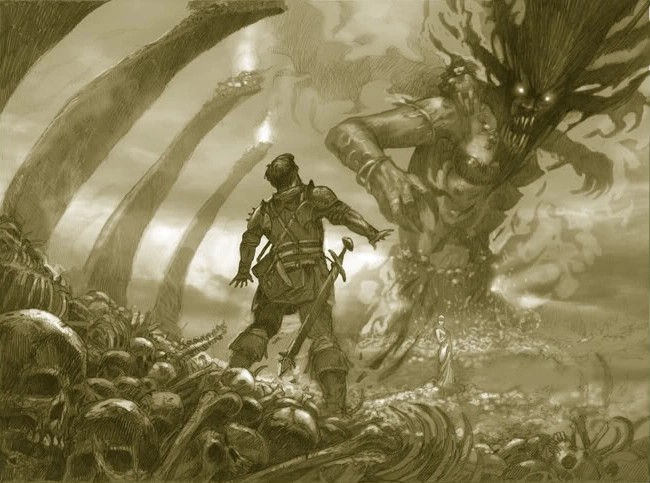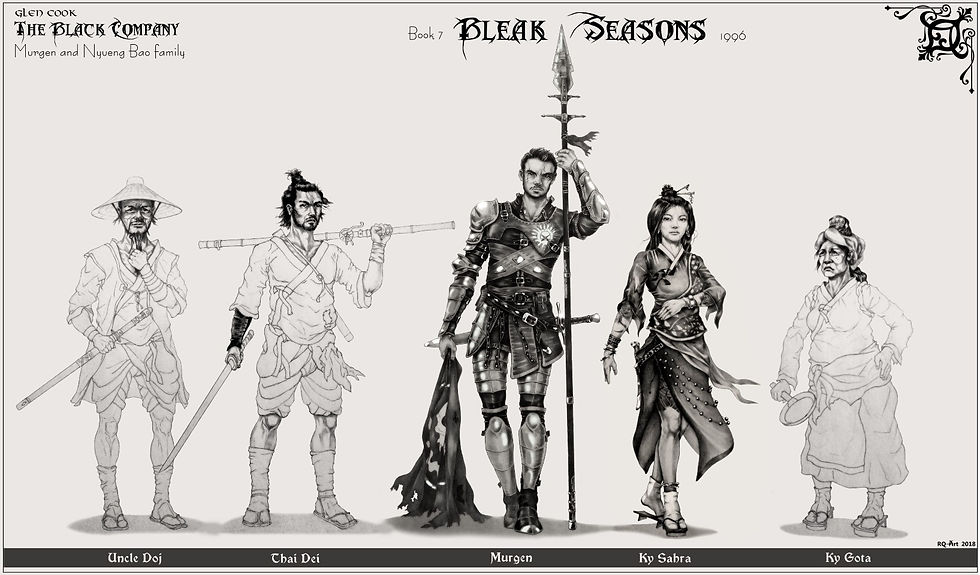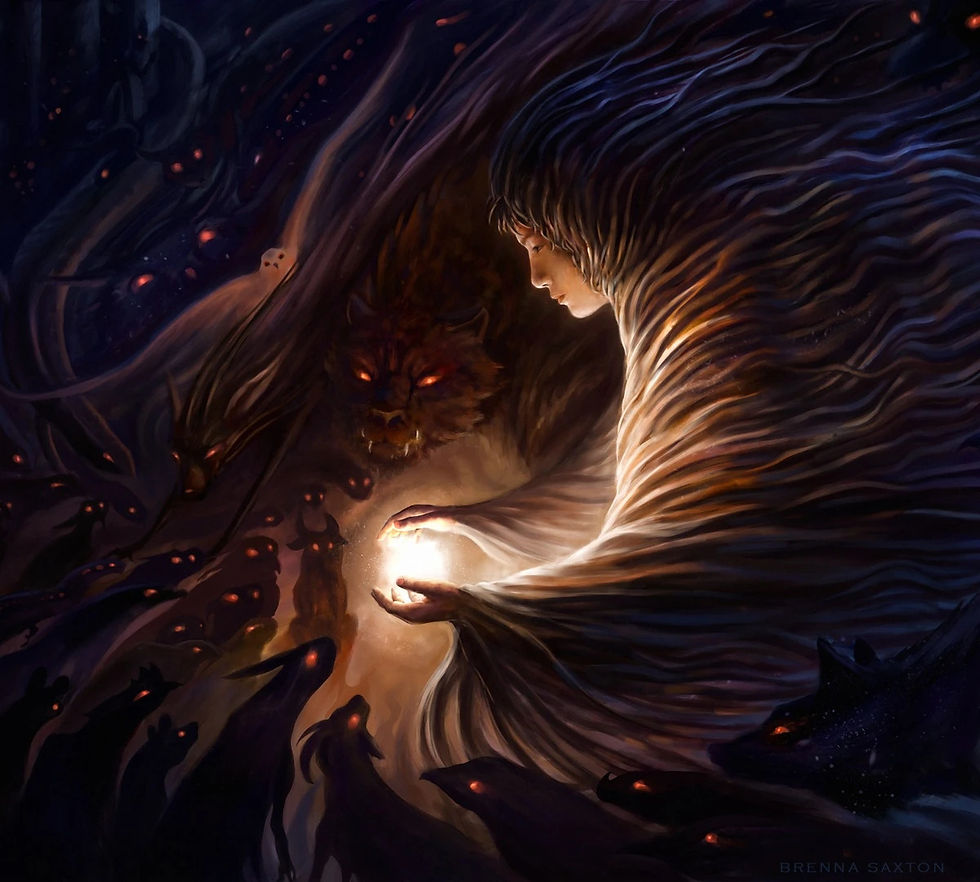The Wonders and Terrors of “The Black Company” [Part II]
- zachlaengert
- Jul 7
- 7 min read
Demons and shadows, religions and sorcerers, the Company and the worlds
At the Shadowgate
This piece is a continuation of my discussion of Glen Cook's The Black Company series of novels, so kindly consider looking at my previous post if you haven't already. I'll also be including more spoilers today – mostly about the world, rather than the plot – so turn back now if you want to read the books unsullied.
I'll be continuing my overview of speculative fiction elements I love in this series, and which are still rarely matched by other works. I'll also point out those bits that don't work for me, and therein reflect further on the idea that we can both love and hate aspects of a thing – a concept that seems to be a little lost in today's world of cancelling, blocking and ghosting.
Life is complex! And art must imitate life, because The Black Company is plenty complex too – both in its story and as a piece of literary history and art.

Magnitude & Depths of History
Time is one thing Cook does very well in The Black Company. For starters, the ten book series takes place over the course of more than forty years: readers witness as age creeps up on the young and middle-age men of the Company like Croaker and Goblin, as it shrivels and claims senior members like One-Eye and the Captain, and as it sees the Company recruit younger generations like Murgen and Sleepy.
Then there's the history of the Company itself, known only by the annals Croaker studies and contributes to. The annals are the Company's identity just as much as its current members are, but the shadows of time have impacted them as well. The original texts, explaining their mysterious origins in Khatovar and initial purpose, are long lost – as are portions of their more recent history, excised by previous annalists for reasons unknown. (If these ideas about memory & identity fascinate you as much as they do me, consider giving Piranesi a read; I also briefly discuss similar ideas in regard to vampires here.)

The passage – and cyclical nature – of time is everywhere in this world, with life and society shaped by endless conflict as I mentioned last week but also with the scars left by powerful sorcerers long past. Think of how figures like Alexander, Genghis, Caesar and Hitler warp history and the world around them – then give them overwhelming magic with which they can extend their own lives and decimate nations with the wave of a hand. That's certainly Cook's vision behind figures like the Dominator and 'the Prisoner', both of whom display world-shattering sorcery during their few moments of freedom in The White Rose.
But a secret of long speculative fiction series is that escalation is inevitable – even if the Company and their allies only barely overcame those historical figures, with every advantage on their side. So, the rest of the series so far focuses on Kina.

Real-world Inspiration
I love Dan Simmons' Hyperion Cantos, and so towards the end of last year I tried to read his first horror novel, Song of Kali (1985). Good grief is that novel offensive to Indian peoples and cultures with its attempted depiction of Kolkata as the most evil city on Earth – it was so bad that it even made me rethink my opinion of Heart of Darkness in addition to, you guessed it, The Black Company.
(Book 4: Shadow Games sees the Company travelling south and features a riverboat sequence through swamps and jungles that calls Heart of Darkness and Apocalypse Now heavily to mind, so suffice to say that Cook certainly wasn't unaware of the comparison.)
I'll lean on the impeccable authority of TV Tropes for what Cook does here:
From The Books of the South onwards, the series takes place in a fantasy counterpart of India, complete with pseudo-Muslims and pseudo-Hindus. The latter even have the practice of suttee and their own thuggee cult (neither of which are even renamed). Not to mention the goddess Kali in the form of Kina. While Taglian territories are Indian analogues, the Shadowlands specifically encompasses the state of Rajasthan. Stormgard/Dejagore/Jaicure is Jaipur, a burg of a city and the capital of Rajasthan, which shares the dry climate of Jaipur; And the gobsmackingly huge Overlook fortress whom borders the Plain of Glittering Stone has its counterpart of named Chittor, which is also gobsmackingly huge and on the southern edge of the province. Beyond geographical similarities, even the name (and the in-universe meaning of it) of the Shadowlands bares striking resemblance to Rajasthan... No, I mean the Shadowlands' other name, Ajastan, the one that means "The Land of Many Kings" (none of which were mentioned by name, as Sleepy notes). (Source)
At the same time, the Nyueng Bao are based heavily on the Khmer Krom people indigenous to southern Vietnam and the Nar from Gea-Xle draws on stereotypes about proud African warrior societies.

Now, is taking inspiration from the real world inherently wrong? Does Cook reach Song of Kali's level of extreme xenophobia? Absolutely not; but it does still come off as (at the very least) casually, lazily offensive to transplant real world history and beliefs directly into a fictional world and portray them as the greatest evil in existence.
On a similar note, I really dislike the fate of the Nar in the books. These warriors are the spiritual and often biological descendants of the early Black Company, from the years they spent in Gea-Xle centuries before. They foreshadow the fact that the Companies of Khatovar were originally pure evil themselves, sent out to conquer and pillage in Kina's name. It's fascinating to see a group of them join up with the Company of the current day, and Mogaba later leading a fraction of them to mutiny is one of the most terrifying moments in the series.
Yet the last loyal Nar survivors, Ochiba and Isi, are unceremoniously discarded off-screen in the same book that the Company's only other known Black characters – Blade and One-Eye – are killed. (Others, like Baldo and Heart-of-the-Lion/"Freak", are simply forgotten between books and presumed dead on account of general statements.) So glad that all these interesting characters were paved over to make room for the two alien teenagers I mentioned last time.
On the other hand, the Nyueng Bao are handled pretty well. I'm not sure why Cook chose to spend six books with the Company in the South, fighting a rotating lineup of Soulcatcher, Mogaba and Longshadow on repeat, but here we are, and the Nyueng Bao characters are allowed time to blossom as a result. Murgen and Ky Sahra's relationship of course also produces Tobo, a remarkably talented young sorcerer now studying under the Lady with her powers reinstated.

Lightning Round! (I will finish with this today or so help me Croaker)
'Demons' in this world are simply beings summoned by wizards from beyond, and include everything from literal imps to dragons to people to the Father Tree itself. I love the way this broad categorization allows Cook to have fun in a fantasy setting while also keeping things mysterious and imbuing these creatures with a great sense of danger.
'Shadows' are undead souls bound into service by certain wizards, including the Shadowmasters who serve as villains for a number of books. They're another great example of how magic allows corruption and evil to spread through time; only millennia of conflicts and evil rituals would allow the sheer number of shadows that now permeate the worlds. Also fascinating are the 'Unknown Shadows' who behave more like Fey and are in league with Tobo.
The Glittering Plain, where sixteen worlds (parallel universes?) meet and which is overseen by an ancient golem named Shivetya – whose body, godlike powers, immortality and responsibilities are taken over by an aging Croaker at the end of Soldiers Live. Kina herself is imprisoned beneath the golem, mirroring the Father Tree overseeing his unnamed Prisoner. I love this world-between-worlds and exploration stuff to no end – just take a look at my Narnia/Magicians and House of Leaves pieces. The mystery is heightened all the more by the Company's search for their origins at Khatovar, and the way their quest slowly gets stranger and stranger.
Lady & Soulcatcher are still around at the end of Soldiers Live, despite the incredible amount of attrition suffered by the Company over the course of ten books and forty years (now in both our world and that of the series, funnily enough). The former even has her powers back now thanks to Croaker; I'll be utterly fascinated to see what plans Cook has for the pair of them going forwards.

Final Thoughts (For Now)
I think it's fair to say that I do still like this series, despite its major flaws. I still have no intention of reading Port of Shadows, which is semi-canonical anyway. I'm also incredibly unsure about the four new books coming out over the next few years: both because of the direction Cook's writing seems to have gone in Port of Shadows and because we're dealing with an almost entirely new cast at this point – possibly led by Shukrat and Arkana, who just leave a bad taste in my mouth. Not to mention that Kina was finally defeated at the end of Soldiers Live, so another wild escalation is pretty likely.
But just maybe, Cook will once again capture that feeling of the Company lost and alone against the world, traversing history and stumbling into mysteries while avoiding the footfalls of titans liable to crush them.
Could we return to the North, to catch up with Whisper and the Master? Open up the thirteen closed shadowgates? Or find a way into other planes entirely, those from which wizards pull their chaotic and dangerous array of demonic servants? Or will there be another four-book war for Taglios, after its central role in the last six books? It will be very interesting to see.
Would love to hear your thoughts! Have you been convinced to try the series? Never to touch it? How's your excitement vs. anxiety for Lies Weeping, coming this November?
I'm sure I'll return to write more about these books at some point, but for now:
Thanks for reading and until next time <3







Comments